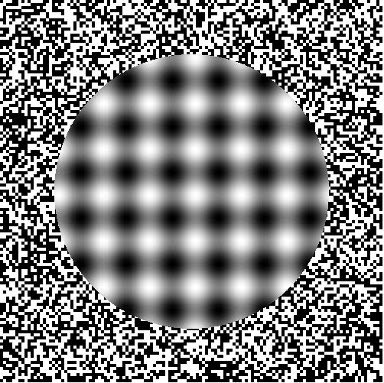
The Enigma Illusion - As you view the Enigma image, notice how the concentric purple rings appear to fill with rapid circular motion, as if millions of tiny and barely visible cars were driving around a track. The illusory motion is driven by microsaccades: small, involuntary eye movements that occur during visual fixation.

Enigmatic Eye - Look at the center of the pupil and you will see the surrounding purple rings fill with rapid illusory motion. Neuroscientist and engineer Jorge Otero-Millan's tribute to Leviant features the illusory motion seen in Enigma, and it also reflects the role of eye movements in the perception of the illusion.

Kitaoka's Op Art - Hatpin Urchin, by Kitaoka, dramatically demonstrates the importance of eye movements in the perception of this kinetic illusion.

MacKay Rays - This illusion, created in 1957 by neuroscientist Donald M. MacKay, shows that simple patterns of regular or repetitive stimuli, such as radial lines (called "MacKay rays") can induce the perception of shimmering or illusory motion at right angles to those of the pattern. To see the illusion, look at the center of the circle and notice the peripheral shimmering.

The Ouchi Illusion - This illusion is by op artist Hajime Ouchi. Move your head back and forth as you let your eyes wander around the image and notice how the circle and its background appear to shift independently of one another.

The Ouchi Illusion II - This illusion is a contemporary variation on the Ouchi pattern, by Kitaoka.

Bridget Riley's Motion Illusions - This pattern, by op artist Bridget Riley, gives the impression of fast spiraling motion as observers move their eyes around the image.

Bridget Riley's Motion Illusion II - In a tribute to Riley, vision scientist Nick Wade of the University of Dundee in Scotland created an example that features both streaming and shimmering motion, and it is reminiscent of various famous Riley artworks.

The Rotating-Tilted-Lines Illusion - The Rotating-Tilted-Lines Illusion, by vision scientists Simone Gori and Kai Hamburger, is a novel variation of the Enigma effect and Bridget Riley's Blaze. To best observe the illusion, move your head closer and then farther away from your computer screen. As you approach the image, notice that the radial lines appear to rotate counterclockwise. As you move away from the image, they appear to rotate clockwise.

BBC Wallboard - MacKay first observed this effect on the wallboard of a BBC studio: the broadcasting staff had been annoyed by illusory shadows running up and down blank strips between columns of parallel lines.

wow! very nice ! xD
ReplyDeletegreat!...lovely confuses eyes!
ReplyDelete